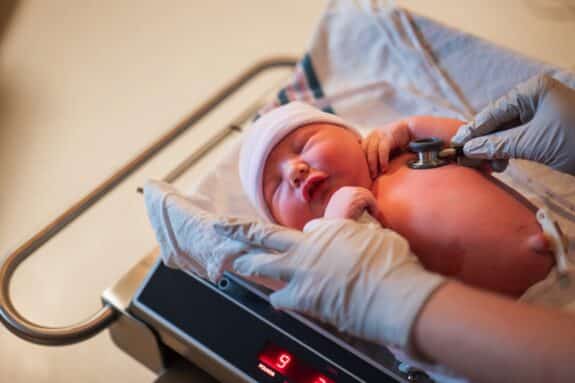When you become a parent, there are a few moments you’ll never forget: that first cry, the first time you see your baby’s face, and for some, those terrifying early hours when something might be wrong.
For parents of preemies or medically fragile babies, one of the first hurdles they face is often a confusing and frightening term: sepsis.
It’s a word doctors don’t take lightly—and for good reason. Sepsis is a potentially deadly response to infection, and in newborns, especially those born early, it can spiral quickly. But here’s the challenge: in the first days of life, it’s incredibly difficult to tell which babies are actually sick and which ones just look a bit off.
As a result, many newborns—especially premature ones—are started on antibiotics just in case.
Now, a new study suggests there may be a way to tell sooner, more accurately, and without putting more stress on tiny bodies. The answer may be hiding in a place most of us forget even exists after birth: the umbilical cord.
The Dilemma in Today’s NICUs
When a baby is born and shows signs that could mean sepsis—maybe their breathing is off, or their temperature isn’t quite right—doctors are trained to act fast. Sepsis moves quickly. And no one wants to be the one who misses it.
So, they start antibiotics, often before there’s even time to wait for lab results.
But here’s the kicker: most of the babies given antibiotics for “presumed sepsis” don’t actually have it.
In fact, national data shows that while only 1% of very low birth weight infants have culture-confirmed sepsis, up to 26% are treated with antibiotics anyway.
This isn’t because anyone’s doing anything wrong, it’s because the tools we have today don’t give us clear answers fast enough. Blood cultures can take days. Clinical signs are vague. And in the absence of better diagnostics, doctors default to caution.
But all that caution comes at a cost.
The Cost of “Just in Case”
Antibiotics save lives. But in newborns, they’re not without side effects. Early and prolonged antibiotic exposure can disrupt the gut microbiome—critical to the development of a baby’s immune system. It can increase the risk of serious complications like necrotizing enterocolitis, a potentially deadly condition affecting the intestines. There’s even evidence it may contribute to long-term health issues, like allergies and metabolic problems.
So, while it makes sense to start antibiotics when there’s a real risk, we also need ways to avoid giving them when they’re not necessary.
This is where the new research from Lurie Children’s Hospital and Northwestern University comes in—and why it’s so exciting.
The Power of Cord Blood
Researchers looked at whether umbilical cord blood—something already present at birth and easily collected—might hold clues that could help doctors tell which babies truly need antibiotics.
Their study, published in JCI Insight, focused on early-onset neonatal sepsis (EOS), which occurs within the first 72 hours of life. Using advanced techniques, the team analyzed hundreds of proteins in cord blood samples from three groups:
- Babies with confirmed sepsis.
- Babies who were treated for sepsis but had negative blood cultures (i.e., presumed sepsis).
- Healthy babies with no signs of infection.
What they found was compelling: three proteins stood out in the babies who had real, confirmed infections.
- C-reactive protein (CRP) – a well-known marker of inflammation.
- Serum amyloid A (SAA) – another protein that rises during infection.
- Lipopolysaccharide-binding protein (LBP) – which responds to bacterial toxins.
These markers were significantly higher in the babies who had sepsis. And, in the majority of babies treated just in case, levels of these proteins were low, suggesting they may not have needed antibiotics after all.
A Potential Game-Changer for Newborn Care
So what does this mean in practice?
Imagine this: a preemie is born to a mom who had a suspected infection. The baby looks a little off, so doctors start antibiotics right away. But alongside those first tests, a cord blood panel is also sent off. Within hours, the results show low levels of CRP, SAA, and LBP, well within the healthy range.
With that information, the care team might feel more confident stopping antibiotics early, rather than continuing them for the standard full course. On the flip side, if levels are high, it supports the decision to continue treatment without delay.
In other words, this test won’t replace clinical judgment, but it adds a new layer of data that can support smarter, safer decisions.
What About Babies Who Get Sick Later?
It’s worth noting that this approach wouldn’t catch every case. A small number of infants in the study had low levels of the biomarkers at birth but later developed sepsis a couple of days into life. Their cultures were only positive after they’d already begun to show other signs of illness.
That’s why the researchers emphasize this test should be part of a bigger picture, used alongside other tools, not in isolation.
And for now, this is still early-stage research. The findings are promising, but more studies are needed before cord blood screening becomes standard in delivery rooms.
Perhaps the most striking takeaway from the study is just how many babies could benefit. In the group of babies treated for presumed sepsis, only 12 out of 53 had elevated biomarker levels. That means up to 78% may have received antibiotics they didn’t need.
For those babies, skipping or shortening that course could make a meaningful difference in long-term health.
And for parents, especially those navigating the whirlwind of a NICU stay, any step that reduces risk and adds clarity is a welcome one.
If you’re expecting a baby—especially if there’s a risk of preterm birth—this research may offer hope that newborn care is becoming more personalized, more precise, and more protective.
While this test isn’t widely available yet, it’s part of a growing movement in medicine toward less guessing and more evidence-based care, even from a baby’s very first moments.
In the meantime, parents can ask their care team:
- How is sepsis typically evaluated here?
- What signs do you look for before starting antibiotics?
- Will you use any biomarker tests?
- How soon can we reassess the need for antibiotics?
Sepsis in newborns is serious—and so is overtreatment. The goal is to catch every real infection without subjecting healthy babies to unnecessary medication.
Thanks to this study, we’re one step closer to that goal. By turning to cord blood for answers, researchers are giving us a new way to protect little ones from the beginning.
Source:
Mithal LB, et al. Cord blood proteomics identifies biomarkers of early-onset neonatal sepsis. JCI Insight. 2025. Read study
Related Health News:
- Why Infant Mortality Is Rising Again in the U.S.
- New Study Finds Link Between Vitamin D Deficiency at Birth and Mental Health Risks
- Too Much Fluoride? Research Finds Even Low Levels May Affect Kids’ IQ
Best Diaper Bags
This post includes affiliate links where we will receive a small percentage if you purchase through the link.







